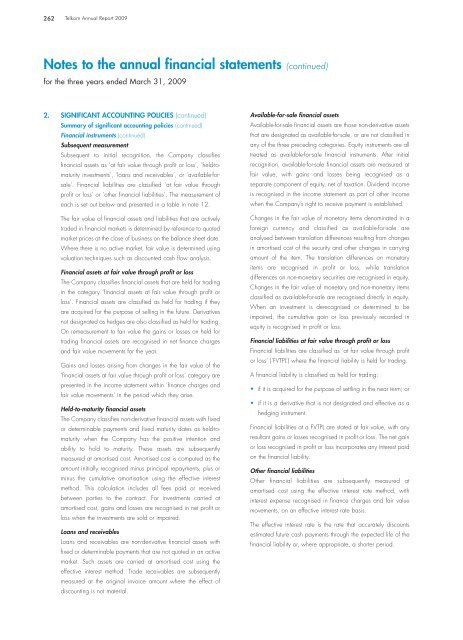Telkom AR front.qxp
Telkom AR front.qxp
Telkom AR front.qxp
You also want an ePaper? Increase the reach of your titles
YUMPU automatically turns print PDFs into web optimized ePapers that Google loves.
262<br />
<strong>Telkom</strong> Annual Report 2009<br />
Notes to the annual financial statements (continued)<br />
for the three years ended March 31, 2009<br />
2. SIGNIFICANT ACCOUNTING POLICIES (continued)<br />
Summary of significant accounting policies (continued)<br />
Financial instruments (continued)<br />
Subsequent measurement<br />
Subsequent to initial recognition, the Company classifies<br />
financial assets as ’at fair value through profit or loss’, ’held-tomaturity<br />
investments’, ’loans and receivables’, or ’available-forsale'.<br />
Financial liabilities are classified ’at fair value through<br />
profit or loss’ or ’other financial liabilities’. The measurement of<br />
each is set out below and presented in a table in note 12.<br />
The fair value of financial assets and liabilities that are actively<br />
traded in financial markets is determined by reference to quoted<br />
market prices at the close of business on the balance sheet date.<br />
Where there is no active market, fair value is determined using<br />
valuation techniques such as discounted cash flow analysis.<br />
Financial assets at fair value through profit or loss<br />
The Company classifies financial assets that are held for trading<br />
in the category ’financial assets at fair value through profit or<br />
loss’. Financial assets are classified as held for trading if they<br />
are acquired for the purpose of selling in the future. Derivatives<br />
not designated as hedges are also classified as held for trading.<br />
On remeasurement to fair value the gains or losses on held for<br />
trading financial assets are recognised in net finance charges<br />
and fair value movements for the year.<br />
Gains and losses arising from changes in the fair value of the<br />
’financial assets at fair value through profit or loss’ category are<br />
presented in the income statement within ’finance charges and<br />
fair value movements’ in the period which they arise.<br />
Held-to-maturity financial assets<br />
The Company classifies non-derivative financial assets with fixed<br />
or determinable payments and fixed maturity dates as held-tomaturity<br />
when the Company has the positive intention and<br />
ability to hold to maturity. These assets are subsequently<br />
measured at amortised cost. Amortised cost is computed as the<br />
amount initially recognised minus principal repayments, plus or<br />
minus the cumulative amortisation using the effective interest<br />
method. This calculation includes all fees paid or received<br />
between parties to the contract. For investments carried at<br />
amortised cost, gains and losses are recognised in net profit or<br />
loss when the investments are sold or impaired.<br />
Loans and receivables<br />
Loans and receivables are non-derivative financial assets with<br />
fixed or determinable payments that are not quoted in an active<br />
market. Such assets are carried at amortised cost using the<br />
effective interest method. Trade receivables are subsequently<br />
measured at the original invoice amount where the effect of<br />
discounting is not material.<br />
Available-for-sale financial assets<br />
Available-for-sale financial assets are those non-derivative assets<br />
that are designated as available-for-sale, or are not classified in<br />
any of the three preceding categories. Equity instruments are all<br />
treated as available-for-sale financial instruments. After initial<br />
recognition, available-for-sale financial assets are measured at<br />
fair value, with gains and losses being recognised as a<br />
separate component of equity, net of taxation. Dividend income<br />
is recognised in the income statement as part of other income<br />
when the Company’s right to receive payment is established.<br />
Changes in the fair value of monetary items denominated in a<br />
foreign currency and classified as available-for-sale are<br />
analysed between translation differences resulting from changes<br />
in amortised cost of the security and other changes in carrying<br />
amount of the item. The translation differences on monetary<br />
items are recognised in profit or loss, while translation<br />
differences on non-monetary securities are recognised in equity.<br />
Changes in the fair value of monetary and non-monetary items<br />
classified as available-for-sale are recognised directly in equity.<br />
When an investment is derecognised or determined to be<br />
impaired, the cumulative gain or loss previously recorded in<br />
equity is recognised in profit or loss.<br />
Financial liabilities at fair value through profit or loss<br />
Financial liabilities are classified as ‘at fair value through profit<br />
or loss’ (’FVTPL’) where the financial liability is held for trading.<br />
A financial liability is classified as held for trading:<br />
• if it is acquired for the purpose of settling in the near term; or<br />
• if it is a derivative that is not designated and effective as a<br />
hedging instrument.<br />
Financial liabilities at a FVTPL are stated at fair value, with any<br />
resultant gains or losses recognised in profit or loss. The net gain<br />
or loss recognised in profit or loss incorporates any interest paid<br />
on the financial liability.<br />
Other financial liabilities<br />
Other financial liabilities are subsequently measured at<br />
amortised cost using the effective interest rate method, with<br />
interest expense recognised in finance charges and fair value<br />
movements, on an effective interest rate basis.<br />
The effective interest rate is the rate that accurately discounts<br />
estimated future cash payments through the expected life of the<br />
financial liability or, where appropriate, a shorter period.




